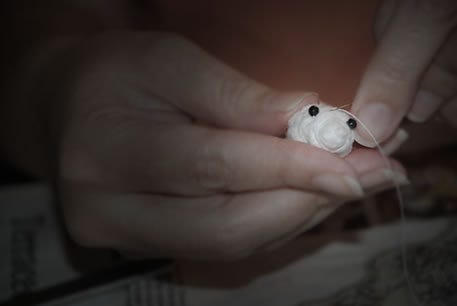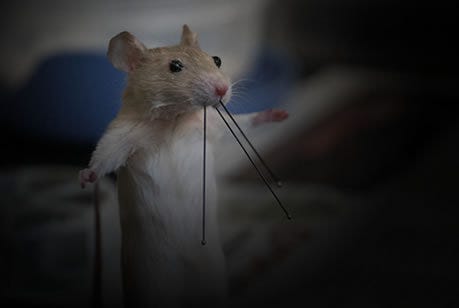
By Annetta Black
The walls and shelves of Paxton Gate on Valencia are laden with dead things: rows of mounted heads, cases of skulls, hundreds of exotic insects behind glass. Combined with an abundance of plants, shells, and botanical illustrations, it is one part Ye Olde Curiosity Shoppe, one part Natural History Museum. Among these natural findings are few unnatural interlopers: mice with tiny angel wings, and some stylishly outfitted larger creatures with skeletal appendages.
In this taxidermy paradise, I set out to explore how they go from carcass to art.

Re-animated
I decide to start with the small and cute, so I seek out Jeanie M., the elusive artist behind the tiny taxidermied and costume-bedecked mice and mouse-skull angels which are a popular feature at the shop. She occasionally teaches classes there, but I meet with her at her studio for a private peek at her mousy process.
I’m not particularly squeamish, but I’ve never been around the taxidermy process either, so I’m a little nervous. Jeanie, on the other hand, works with the ease and quickness that comes from familiarity. She chats and points out details of her technique while her little white-pawed cat rubs up against my legs, eyeballing the mice still thawing on top of the mini-fridge. The relative tastiness of Jeanie’s art (to pets at least) has caused some problems — both in her own household and with clients. Right now she is re-making two different wedding cake toppers that were recently destroyed by client’s pets.
The process is straightforward, but fiddly. She makes it look easy, but I am confident that it looks easier than it is, as she neatly skins a mouse in minutes leaving his tiny feet and facial features unmarred.

A wire armature is inserted to give strength and short-term flexibility to the legs and tail, followed by a tiny mouse-shaped form made of cotton balls and wire and two black beads stitched on for eyes.
“I sometimes make these when I’m on an airplane. People ask what I’m making, and I tell them ‘dolls’. That makes them happier.”
Once the forms are inserted, they instantly look mouse-like again. The skin is closed with invisible stitches, and with a few deft twists of the tail and feet they stand up on their own. She smooths the ears, moves his paws into place, and pins his mouth into a more natural pose with three large pins. It’s surprisingly quick and bloodless, all things considered.
She keeps her costume parts in tiny drawers along the back of her studio. Drawers are labeled things like “Pope Hats” and “Pirate” and “Angel Wings.” She shows me her portfolio of mice past: angels and demons, scenes from Hamlet, punk rock mice with tiny mohawks, little goths with dog collars. She has a half dozen drying on the shelf, and another six ready to start, plus a freezer full of mousicles. It’s fall, and with the holidays approaching, it’s her busy season.

Drop Dead Gorgeous
A couple of days later, I visit with Monique Motil in her home in the Richmond. I first came across her Sartorial Creatures in the pages of Christopher Moore’s novel A Dirty Job, but I’ve known of Monique and her darkly humorous costuming prowess before that. The creatures, assembled with bits and pieces of various animals, are an offshoot from her full scale costuming projects — a way to use up the bits of pretty shiny things that get left over. In Moore’s book, the creatures are diminutive denizens of the underworld, plotting darkly and living in the sewers of San Francisco. When you look at them, it’s easy to see how he was inspired — they have little personalities, and look like they might talk back.
Her smartly dressed creations are about a foot tall, detailed and delicate with animal skulls for heads, claws or taxidermied hands, and elaborate period costumes and accessories. All of her female creatures sport little fancy bloomers beneath their skirts. In her living room, display cases show off some of her work along with a selection of skulls. She points out a missing foot on one, and the re-enforced latch to keep her cat from sampling further.
When I visit, she is getting started on a pirate. On her workbench, she has an alligator head selected, with blue crab claws for hands. The chicken feet are still drying in the desiccating mixture — not quite ready yet. She has his costume cut out and ready to sew in luxurious fabrics — knee breeches, a little vest, miscellaneous ruffles. A big fancy hat is planned. It looks like a lot of work.
Each year for the Edwardian Ball in January, she makes a thematic batch of creatures to display and sell. Last year’s group is nearly gone, and it’s just about time to get started on next year’s batch. She has not decided just yet, but perhaps a Victorian tea party will be in the works.

Meet The Beetles
From Monique’s I headed to Paxton Gate’s monthly hands-on insect mounting class. I’m feeling pretty confident about this after seeing Jeanie and Monique’s work: after all, there will be no skinning required, and no miniature costumes. How hard can it be?
Kylea Borges, our instructor, starts up by introducing us to the shiny green Chrysochroa opulenta beetles and quickly runs through the steps of soaking and carefully arranging them with about a thousand tiny pins. I’m worried — it looks a little more complicated than expected. As she passes them out I am crossing my fingers that mine comes with sturdy parts. She warns us that they may be a little stinky.
The beetle is weightless, hard, and slightly damp, his legs and antennae tucked up tightly against his body. My beetle has a sliver of delicate brown wing sticking out from between his perfect glossy outer shell. I feel like it is the beetle equivalent of accidentally tucking your skirt into your pantyhose. I am embarrassed for him.
It is hard to find the right place to hold the beetle while I maneuver his legs out from under him. As I am gently prying a leg out, wondering how much force it is supposed to take, one of my classmates sings out, “Well, there goes one leg”. Each little leg makes a tiny and slightly horrifying snapping noise as it pops out away from the body. Each time I expect it to go flying off. Kylea informs us that she keeps a stash of extra parts, and recommends a particular brand of glue for later use. At the other table, a certain beetle now only has two legs. With my beetle’s tiny legs finally maneuvered out of the way I placed my anchor pin, which goes in through the tough exoskeleton. It is harder than I expect and it makes another unsettling crunch. All the remaining pins go around, not through, the beetle, and I am glad for that. We anchor legs in place, arrange antennae, trying to keep it symmetrical while not snapping off tiny appendages.
When I am done, an hour and several dozen pins later, I am proud of my work. My beetle has all six legs, and a saucy little handlebar moustache of antennae.

Flight of fancy
Our next victims are rainbow colored Madagascar Sunset Moths with about a 3" wingspan and fuzzy little black bodies. The moths are insanely delicate. In order to mount them, they also need to be pinned, but their gossamer wings can not be touched by hands at all, lest we tear them or remove the microscopic scales that provide their color and shimmer. We get handy with the forceps and use velum sheets to ease the wings down and away from the body. My moth only has one antennae. I wonder if I can get another from the parts box — maybe a big dramatic one. I kind of like the idea of some rogue taxidermy on this scale — the body from this beetle, head from another, grab some decorative antennae, miscellaneous legs. Frankenstein Beetle.I find myself wondering if I have any good looking insects in my neighborhood. Luckily for my future hobby time, most of these sexy beasts seem to herald from the exotic tropics.
The final part of mounting the moth is manipulating the wings, which have been closed up in a less showy position, into a more dramatic spread. This is done without directly touching the wings, yet holding them in place, using just the tip of one tiny pin to slide them into place — while being careful to not tear holes, which I do almost immediately. You need three hands and a prehensile tail to get the appropriate angle and hold to do this. The classroom fills with muttered curses as we attempt to not destroy the beautiful wings. The instructor makes reassuring little statements, like, “It’s nearly inevitable. Don’t worry too much about it”.
By the time I give up, my moth is not perfectly symmetrical, and his lower wings are perhaps not as high and jaunty as they should be, but I am pretty sure my house guests won’t notice. Resisting the urge to mess with it further, I rapidly pin the velum protection in place before I can change my mind. I am pretty sure that big ragged chunks of wing are going to fall off when I remove it from the mounting board.
As the class wraps up, we tuck our new little friends into a box to take home and dry for a few weeks before we can dismount them and put them into some sort of a display case. I am very proud of my beetle and moth, wing mishaps notwithstanding.
Back in the main shop, I pay more attention to the mounting styles on display. Some of their beetles have multi-layered wings fanned out with Dali-esque antennae, enormous spiders perched on long brittle legs, and butterflies are shown with immaculate wings raised for flight, both antennae attached. Clearly, there’s more to learn. I might just come back for another round, build up the old cabinet of curiosities.
Design: Gordon Baty







